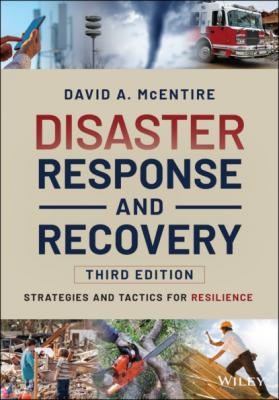Disaster Response and Recovery. David A. McEntire
Читать онлайн.| Название | Disaster Response and Recovery |
|---|---|
| Автор произведения | David A. McEntire |
| Жанр | Социальная психология |
| Серия | |
| Издательство | Социальная психология |
| Год выпуска | 0 |
| isbn | 9781119810056 |
Figure 2‐4 FEMA has 10 regional offices around the United States.
Source: FEMA.
For Example
General Governmental Responsibilities
The number of government entities involved in disasters can be quite overwhelming and operations can be fairly complex. But the government is best understood by simplifying roles and responsibilities into three general areas. The federal government often provides financial assistance and other necessary resources to support state and local governments. The state government manages federal funds and oversees local government response and recovery functions. City and county governments implement required operations to care for victims and facilitate recovery.
The National Response Framework is a planning document that describes what the government will do in catastrophic disasters. It deals with the immediate needs made evident by a disaster. The National Disaster Recovery Framework, in contrast, is a guide to enable effective long‐term rebuilding in disaster‐stricken areas. This guideline provides those involved in disaster recovery with a flexible structure to restore affected communities. Some of the organizations involved in these plans take on primary responsibilities, while others perform support functions. Several of these departments and agencies are listed in Table 2‐1.
Table 2‐1 Federal Departments and Their Role in a Disaster
| Department/agency | Disaster functions |
|---|---|
| U.S. Department of Agriculture (USDA) | Suppresses rural and urban fires |
| U.S. Department of Commerce (DOC) | Provides information and assists with planning, resource support, communications, and hazardous material incidents |
| U.S. Department of Defense (DOD) | Assists with public works and engineering, flood control, transportation, urban search and rescue, firefighting, mass care, and health and medical services. The DOD may also become involved in the detection and response to hazardous material spills and weapons of mass destruction |
| U.S. Department of Education (DOED) | Collects, processes, and disseminates critical information |
| U.S. Department of Energy (DOE) | Restores energy systems and reacts to nuclear power plant emergencies |
| U.S. Department of Health and Human Services (HHS) | Supplements local and state public health and medical operations Provides or reestablishes temporary and permanent housing |
| U.S. Department of Housing and Urban Development (HUD) | Provides or reestablishes temporary and permanent housing |
| U.S. Department of the Interior (DOI) | Supports with information and planning, emergency, communications, firefighting, and hazardous material functions |
| U.S. Department of Justice (DOJ) | Participates in information and planning, urban search and rescue, health and medical services, and hazardous material issues. Also ensures that all laws pertaining to disaster assistance are followed |
| U.S. Department of Labor (DOL) | Contributes to public works, engineering, resource support, urban search and rescue, and hazardous material areas |
| U.S. Department of State (DOS) | Takes part in transpiration, energy, and hazardous material services |
| U.S. Department of Transportation (DOT) | Fulfills transportation, information and planning, energy, hazardous material duties after a disaster |
| U.S. Department of Treasury (TREAS) | Funds long‐term recovery projects and mitigation measures |
| U.S. Department of Veterans Affairs (VA) | Seeks assistance for veteran needs after a disaster as well as mass care and health and medical services |
| U.S. Environmental Protection Agency (EPA) | Responds to and cleans up hazardous material spills and also works in firefighting, health and medical services |
| National Communications System | Facilitates communications after a disaster |
| General Services Administration (GSA) | Aids in logistical activities such as transportation, information and planning, mass care, and food distribution roles |
| National Aeronautics and Space Administration (NASA) | Completes urban search and rescue and other functions in reference to satellites and remote sensing |
| Nuclear Regulatory Commission (NRC) | Shares expertise in energy and hazardous material disasters involving nuclear plants |
| Office of Planning and Management (OPM) | Advances logistical and resource support to all other federal agencies involved in disaster response or recovery |
| Small Business Administration (SBA) | Offers financial assistance to individuals and businesses affected by disasters |
| Social Security Administration (SSA) | Supplies mass care, housing, and human services needs |
| Tennessee Valley Authority (TVA) | Makes available transportation, public works, engineering, and energy services |
| US Agency for International Development (USAID) | Supplies urban search and rescue resources and disaster relief |
| U.S. Postal Service (USPS) | Imparts transportation support |
There are many other agencies and individuals that deal with disasters and emergency
